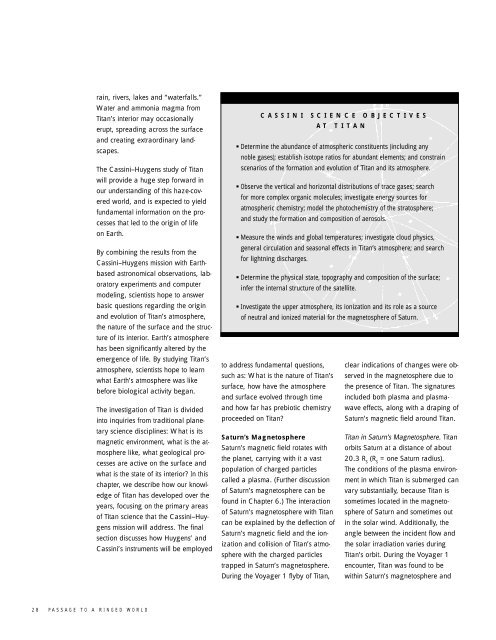Passage to a Ringed World - NASA's History Office
Passage to a Ringed World - NASA's History Office
Passage to a Ringed World - NASA's History Office
You also want an ePaper? Increase the reach of your titles
YUMPU automatically turns print PDFs into web optimized ePapers that Google loves.
28 PASSAGE TO A RINGED WORLD<br />
rain, rivers, lakes and “waterfalls.”<br />
Water and ammonia magma from<br />
Titan’s interior may occasionally<br />
erupt, spreading across the surface<br />
and creating extraordinary landscapes.<br />
The Cassini–Huygens study of Titan<br />
will provide a huge step forward in<br />
our understanding of this haze-covered<br />
world, and is expected <strong>to</strong> yield<br />
fundamental information on the processes<br />
that led <strong>to</strong> the origin of life<br />
on Earth.<br />
By combining the results from the<br />
Cassini–Huygens mission with Earthbased<br />
astronomical observations, labora<strong>to</strong>ry<br />
experiments and computer<br />
modeling, scientists hope <strong>to</strong> answer<br />
basic questions regarding the origin<br />
and evolution of Titan’s atmosphere,<br />
the nature of the surface and the structure<br />
of its interior. Earth’s atmosphere<br />
has been significantly altered by the<br />
emergence of life. By studying Titan’s<br />
atmosphere, scientists hope <strong>to</strong> learn<br />
what Earth’s atmosphere was like<br />
before biological activity began.<br />
The investigation of Titan is divided<br />
in<strong>to</strong> inquiries from traditional planetary<br />
science disciplines: What is its<br />
magnetic environment, what is the atmosphere<br />
like, what geological processes<br />
are active on the surface and<br />
what is the state of its interior? In this<br />
chapter, we describe how our knowledge<br />
of Titan has developed over the<br />
years, focusing on the primary areas<br />
of Titan science that the Cassini–Huygens<br />
mission will address. The final<br />
section discusses how Huygens’ and<br />
Cassini’s instruments will be employed<br />
CASSINI SCIENCE OBJECTIVES<br />
AT TITAN<br />
■ Determine the abundance of atmospheric constituents (including any<br />
noble gases); establish iso<strong>to</strong>pe ratios for abundant elements; and constrain<br />
scenarios of the formation and evolution of Titan and its atmosphere.<br />
■ Observe the vertical and horizontal distributions of trace gases; search<br />
for more complex organic molecules; investigate energy sources for<br />
atmospheric chemistry; model the pho<strong>to</strong>chemistry of the stra<strong>to</strong>sphere;<br />
and study the formation and composition of aerosols.<br />
■ Measure the winds and global temperatures; investigate cloud physics,<br />
general circulation and seasonal effects in Titan’s atmosphere; and search<br />
for lightning discharges.<br />
■ Determine the physical state, <strong>to</strong>pography and composition of the surface;<br />
infer the internal structure of the satellite.<br />
■ Investigate the upper atmosphere, its ionization and its role as a source<br />
of neutral and ionized material for the magne<strong>to</strong>sphere of Saturn.<br />
<strong>to</strong> address fundamental questions,<br />
such as: What is the nature of Titan’s<br />
surface, how have the atmosphere<br />
and surface evolved through time<br />
and how far has prebiotic chemistry<br />
proceeded on Titan?<br />
Saturn’s Magne<strong>to</strong>sphere<br />
Saturn’s magnetic field rotates with<br />
the planet, carrying with it a vast<br />
population of charged particles<br />
called a plasma. (Further discussion<br />
of Saturn’s magne<strong>to</strong>sphere can be<br />
found in Chapter 6.) The interaction<br />
of Saturn’s magne<strong>to</strong>sphere with Titan<br />
can be explained by the deflection of<br />
Saturn’s magnetic field and the ionization<br />
and collision of Titan’s atmosphere<br />
with the charged particles<br />
trapped in Saturn’s magne<strong>to</strong>sphere.<br />
During the Voyager 1 flyby of Titan,<br />
clear indications of changes were observed<br />
in the magne<strong>to</strong>sphere due <strong>to</strong><br />
the presence of Titan. The signatures<br />
included both plasma and plasmawave<br />
effects, along with a draping of<br />
Saturn’s magnetic field around Titan.<br />
Titan in Saturn’s Magne<strong>to</strong>sphere. Titan<br />
orbits Saturn at a distance of about<br />
20.3 R (R = one Saturn radius).<br />
S S<br />
The conditions of the plasma environment<br />
in which Titan is submerged can<br />
vary substantially, because Titan is<br />
sometimes located in the magne<strong>to</strong>sphere<br />
of Saturn and sometimes out<br />
in the solar wind. Additionally, the<br />
angle between the incident flow and<br />
the solar irradiation varies during<br />
Titan’s orbit. During the Voyager 1<br />
encounter, Titan was found <strong>to</strong> be<br />
within Saturn’s magne<strong>to</strong>sphere and
















